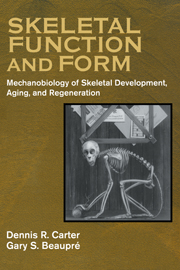Book contents
- Frontmatter
- Contents
- Preface
- Chapter 1 Form and Function
- Chapter 2 Skeletal Tissue Histomorphology and Mechanics
- Chapter 3 Cartilage Differentiation and Growth
- Chapter 4 Perichondral and Periosteal Ossification
- Chapter 5 Endochondral Growth and Ossification
- Chapter 6 Cancellous Bone
- Chapter 7 Skeletal Tissue Regeneration
- Chapter 8 Articular Cartilage Development and Destruction
- Chapter 9 Mechanobiology in Skeletal Evolution
- Chapter 10 The Physical Nature of Living Things
- Appendix A Material Characteristics
- Appendix B Structural Characteristics
- Appendix C Failure Characteristics
- Index
Chapter 7 - Skeletal Tissue Regeneration
Published online by Cambridge University Press: 11 January 2010
- Frontmatter
- Contents
- Preface
- Chapter 1 Form and Function
- Chapter 2 Skeletal Tissue Histomorphology and Mechanics
- Chapter 3 Cartilage Differentiation and Growth
- Chapter 4 Perichondral and Periosteal Ossification
- Chapter 5 Endochondral Growth and Ossification
- Chapter 6 Cancellous Bone
- Chapter 7 Skeletal Tissue Regeneration
- Chapter 8 Articular Cartilage Development and Destruction
- Chapter 9 Mechanobiology in Skeletal Evolution
- Chapter 10 The Physical Nature of Living Things
- Appendix A Material Characteristics
- Appendix B Structural Characteristics
- Appendix C Failure Characteristics
- Index
Summary
Biology and Mechanobiology
Bone fracture or damage triggers a complicated cascade of biological responses that lead to skeletal tissue regeneration. Regeneration is to be distinguished from tissue repair with scar formation since it involves de novo skeletal tissue formation that is accomplished by the proliferation and differentiation of pluripotential mesenchymal stem cells. The mechanobiological factors that regulate skeletal regeneration are similar to those involved in development (Carter, 1987). In this chapter we examine the mechanobiology of skeletal regeneration in four different contexts: (1) tissue differentiation at the interface of a surgical implant, (2) fracture healing, (3) distraction osteogenesis, and (4) neochondrogenesis in joint repair. In Chapter 8 we consider how the mechanobiology of tissue differentiation plays a role in the reparative processes associated with the late stages of osteoarthritis.
Skeletal regeneration is initiated by a traumatic episode that involves damage to the bone that often includes the periosteum, bone marrow spaces, and surrounding soft tissues. Trauma, such as fracture or surgical cutting and drilling, causes a physical disruption of the mineralized tissue matrix, death of many types of cells, and interruption of the local blood supply. Local fibrin clotting of blood follows, and additional necrosis around the trauma site results from the disruption of the vasculature. The necrotic cells release lysosomal enzymes and other products of cell death, thereby initiating the cell proliferation and differentiation processes associated with inflammation and skeletal regeneration.
The inflammatory response begins almost immediately as platelets, polymerphonuclear neutrophils, monocytes, and macrophages appear and fibroblasts and pluripotential mesenchymal cells appear shortly thereafter (Ostrum, Chao, et al., 1994).
Information
- Type
- Chapter
- Information
- Skeletal Function and FormMechanobiology of Skeletal Development, Aging, and Regeneration, pp. 161 - 200Publisher: Cambridge University PressPrint publication year: 2000
